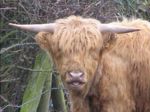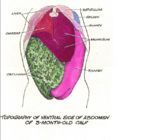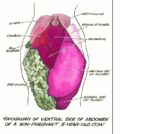Difference between revisions of "Ruminant Stomach - Anatomy & Physiology"
m |
m |
||
| Line 18: | Line 18: | ||
The different compartments of the ruminant stomach develop from the foregut spindle in foetal life. During embyogenesis and after birth the [[The Abomasum|abomasum]] is the largest of the compartments (over half of the weight and capacity of the four stomachs) due to the [[oesophageal groove|Oesophageal Groove]] directing milk from the oesophagus to the [[The Rumen|rumen]] into the [[The Abomasum|abomasum]], bypassing the [[The Reticulum|reticulum]]. | The different compartments of the ruminant stomach develop from the foregut spindle in foetal life. During embyogenesis and after birth the [[The Abomasum|abomasum]] is the largest of the compartments (over half of the weight and capacity of the four stomachs) due to the [[oesophageal groove|Oesophageal Groove]] directing milk from the oesophagus to the [[The Rumen|rumen]] into the [[The Abomasum|abomasum]], bypassing the [[The Reticulum|reticulum]]. | ||
| − | |||
| − | |||
| − | |||
| − | |||
| − | |||
| − | |||
| − | |||
[[The Rumen - Anatomy & Physiology|The Rumen]] | [[The Rumen - Anatomy & Physiology|The Rumen]] | ||
Revision as of 23:29, 25 August 2008
|
|
Introduction
The ruminant stomach is composed of 4 separate compartments. Food passes first into the rumen, then reticulum, omasum and finally into the abomasum before entering the duodenum. The first three compartments are adapted to digest complex carbohydrates with the aid of microorganisms which produce volatile fatty acids - the major energy source of ruminants. The last compartments, the abomasum resembles the simple monogastric stomach in structure and function.
The microorganisms in the ruminant stomach also synthesise all of the B vitamins, vitamin C and vitamin K. Vitamin synthesis in the rumen is sufficient for growth and maintenance. Only vitamins E, D and A should be provided in the ruminant diet. Under normal conditions, ruminants will not require B vitamins added in the diet. Cobalt is needed for vitamin B12 synthesis and so cobalt should be provided in the diet or vitamin B12 injected directly into the bloodstream. In stress conditions, vitamin B3 (Niacin) and vitamin B1 (Thiamine) may also need to be provided in the diet.
The ruminant stomach occupies most of the left hand side of the abdomen. It is a vast structure, holding up to 60 litres in an adult cow. The rumen holds 80%, reticulum 5%, omasum 8% and abomasum 7% in larger ruminants. In smaller ruminants the proportions are slightly different, with the rumen holding 75%, reticulum 8%, omasum 4% and abomasum 13%.
The different compartments of the ruminant stomach develop from the foregut spindle in foetal life. During embyogenesis and after birth the abomasum is the largest of the compartments (over half of the weight and capacity of the four stomachs) due to the Oesophageal Groove directing milk from the oesophagus to the rumen into the abomasum, bypassing the reticulum.


